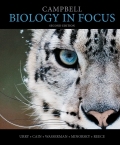
Concept explainers
The immediate energy source that drives ATP synthesis by ATP synthesis during oxidative phosphorylation is the
- A. oxidation of glucose and other organic compounds.
- B. flow of electrons down the electron transport chain.
- C. H+ concentration gradient across the membrane holding ATP synthase.
- D. transfer of phosphate to ADP.
Introduction:
ATP is the energy currency of our body. It is synthesized in the mitochondria by oxidation of glucose (mostly). The process is called oxidative phosphorylation.
Answer to Problem 1TYU
Correct answer:
TCA cycle helps in the production of an electron motive force that is passed along the complexes in the inner mitochondrial membrane (electron transfer chain) and converted to proton motive force. This positive force is then responsible for ATP synthesis. Therefore, option (C) is correct.
Explanation of Solution
Reason for the correct statement:
When the concentration of protons is high outside the membrane of mitochondria, protons are forced through the enzyme ATP synthase. This proton movement makes the ATP synthase to rotate and the production of APT from ADP and inorganic phosphate (Pi).
Option (C) is given as “
“The immediate energy source that drives ATP synthesis by ATP synthase during oxidative phosphorylation is the
Hence, the option (c) is correct.
Reasons for the incorrect statements:
Option (A) is given as “oxidation of glucose and other organic compounds”.
Oxidation of glucose and other organic material actually occurs where the process of ATP synthesis starts; however, it is not the immediate energy source for ATP synthesis. Thus, it is the wrong answer.
Option (B) is given as “flow of electrons down the electron transport chain”.
ETC is responsible for creating the gradient, but it is not the immediate energy source for ATP synthesis. Thus, it is the wrong answer.
Option (D) is given as “transfer of phosphate to ADP”.
The immediate energy source that drives ATP synthesis by ATP synthase during oxidative phosphorylation is the
Hence, options (A), (B), and (D) are incorrect.
Proton gradient created in the inter-membrane space is the reason for ATP generation by enzyme ATP synthase.
Want to see more full solutions like this?
Chapter 7 Solutions
Campbell Biology In Focus
Additional Science Textbook Solutions
Physical Science
Genetics: From Genes to Genomes
Campbell Essential Biology (7th Edition)
Microbiology Fundamentals: A Clinical Approach
Human Physiology: An Integrated Approach (8th Edition)
- Explain in a small summary how: What genetic information can be obtained from a Punnet square? What genetic information cannot be determined from a Punnet square? Why might a Punnet Square be beneficial to understanding genetics/inheritance?arrow_forwardIn a small summary write down:arrow_forwardNot part of a graded assignment, from a past midtermarrow_forward
- Noggin mutation: The mouse, one of the phenotypic consequences of Noggin mutationis mispatterning of the spinal cord, in the posterior region of the mouse embryo, suchthat in the hindlimb region the more ventral fates are lost, and the dorsal Pax3 domain isexpanded. (this experiment is not in the lectures).a. Hypothesis for why: What would be your hypothesis for why the ventral fatesare lost and dorsal fates expanded? Include in your answer the words notochord,BMP, SHH and either (or both of) surface ectoderm or lateral plate mesodermarrow_forwardNot part of a graded assignment, from a past midtermarrow_forwardNot part of a graded assignment, from a past midtermarrow_forward
 Concepts of BiologyBiologyISBN:9781938168116Author:Samantha Fowler, Rebecca Roush, James WisePublisher:OpenStax College
Concepts of BiologyBiologyISBN:9781938168116Author:Samantha Fowler, Rebecca Roush, James WisePublisher:OpenStax College Human Physiology: From Cells to Systems (MindTap ...BiologyISBN:9781285866932Author:Lauralee SherwoodPublisher:Cengage Learning
Human Physiology: From Cells to Systems (MindTap ...BiologyISBN:9781285866932Author:Lauralee SherwoodPublisher:Cengage Learning
 BiochemistryBiochemistryISBN:9781305577206Author:Reginald H. Garrett, Charles M. GrishamPublisher:Cengage Learning
BiochemistryBiochemistryISBN:9781305577206Author:Reginald H. Garrett, Charles M. GrishamPublisher:Cengage Learning Biology (MindTap Course List)BiologyISBN:9781337392938Author:Eldra Solomon, Charles Martin, Diana W. Martin, Linda R. BergPublisher:Cengage Learning
Biology (MindTap Course List)BiologyISBN:9781337392938Author:Eldra Solomon, Charles Martin, Diana W. Martin, Linda R. BergPublisher:Cengage Learning Biology: The Dynamic Science (MindTap Course List)BiologyISBN:9781305389892Author:Peter J. Russell, Paul E. Hertz, Beverly McMillanPublisher:Cengage Learning
Biology: The Dynamic Science (MindTap Course List)BiologyISBN:9781305389892Author:Peter J. Russell, Paul E. Hertz, Beverly McMillanPublisher:Cengage Learning





